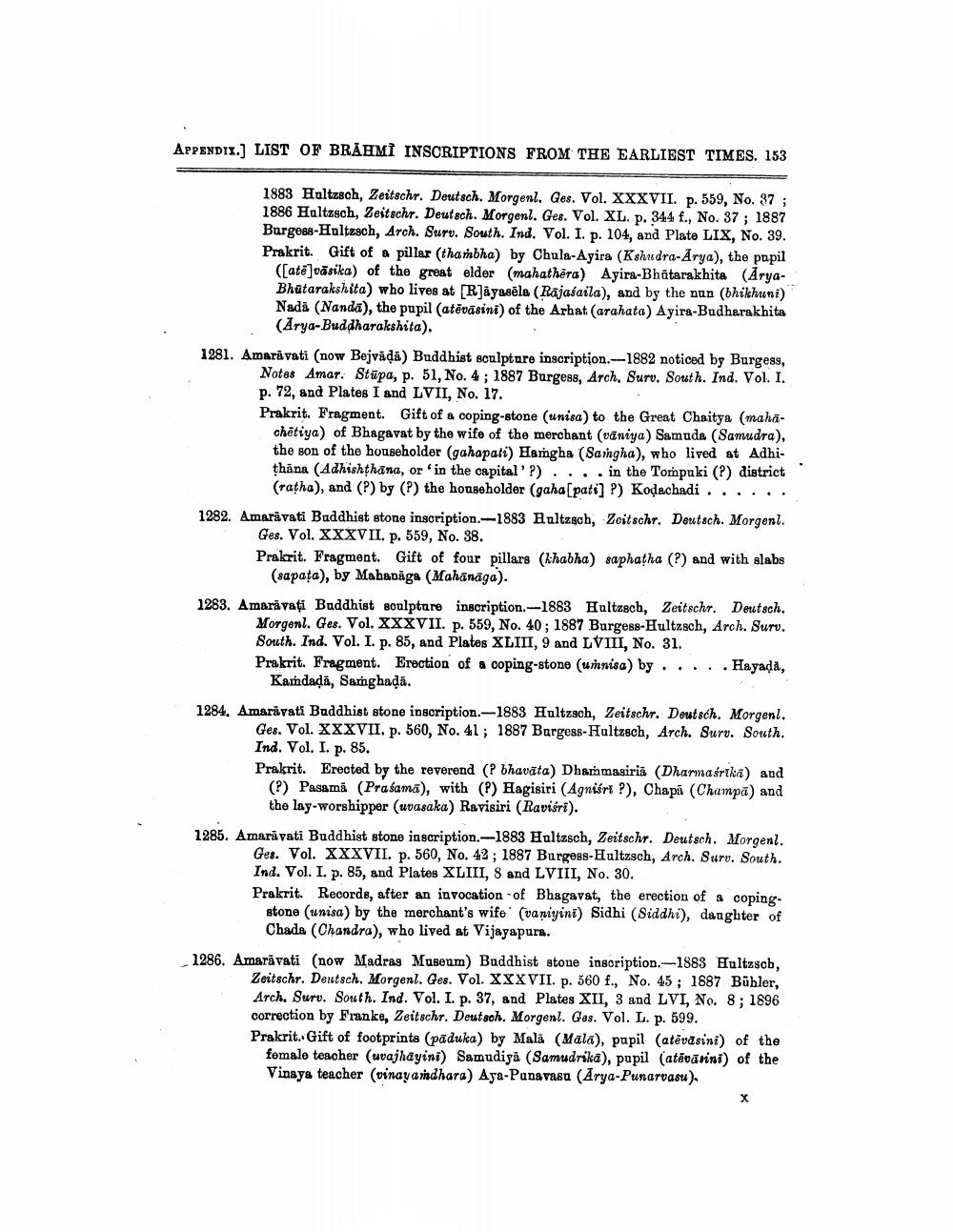________________
Appendix.) LIST OF BRĀHMI INSCRIPTIONS FROM THE EARLIEST TIMES. 153
1883 Hultzsch, Zeitschr. Deutsch. Morgenl. Ges. Vol. XXXVII. p. 559, No. 37 ; 1886 Haltzsch, Zeitschr. Deutsch. Morgenl. Ges. Vol. XL. p. 344 f., No. 37 ; 1887 Burgess-Holtzsch, Arch. Suru. South. Ind. Vol. I. p. 104, and Plate LIX, No. 39. Prakrit. Gift of a pillar (thambha) by Chula-Ayira (Kshudra-Arya), the papil
([atē]vāsika) of the great elder (mahathēra) Ayira-Bhatarakhita (AryaBhatarakshita) who lives at [R]ayasēla (Rajasaila), and by the nun (bhikhuni) Nadi (Nanda), the pupil (atēvāsini) of the Arhat (arahata) Ayira-Budherakhita
(Arya-Buddharakshita). 1281. Amarivati (now Bejvada) Buddhist sculpture inscription.--1882 noticed by Burgess,
Notes Amar. Stūpa, p. 51, No. 4 ; 1887 Burgess, Arch, Suru. South. Ind. Vol. I. p. 72, and Plates I and LVII, No. 17. Prakrit. Fragment. Gift of a coping-stone (unisa) to the Great Chaitya (maha
chētiya) of Bhagavat by the wife of the merchant (vāniya) Samuda (Samudra), the son of the householder (gahapati) Hamgha (Sangha), who lived at Adhithāna (Adhishthāna, or 'in the capital'?).... in the Tompoki (?) district
(ratha), and (P) by (P) the householder (gaha(pati] P) Kodachadi ...... 1282. Amaravati Baddhist stone inscription.-1883 Hultzsch, Zeitschr. Deutsch. Morgenl.
Ges. Vol. XXXVII. p. 559, No. 38. Prakrit. Fragment. Gift of four pillars (khabha) saphatha (?) and with slabs
(sapata), by Mabadága (Mahānāga). 1283. Amaravati Buddhist sculpture inscription.--1883 Hultzsch, Zeitschr. Deutsch,
Morgenl. Ges. Vol. XXXVII. p. 559, No. 40; 1887 Burgess-Hultzsch, Arch. Surv. South. Ind. Vol. I. p. 85, and Plates XLIII, 9 and LVIII, No. 31. Prakrit. Fragment. Erection of a coping-stone (umnisa) by . . . . . Hayada,
Kamdadā, Samghadā. 1284. Amaravati Buddhist stone inscription.-1883 Hultzsch, Zeitschr. Deutsch. Morgenl.
Ges. Vol. XXXVII, p. 560, No. 41; 1887 Burgess-Hultzech, Arch. Surv. South. Ind. Vol. I. p. 85. Prakrit. Erected by the reverend (? bhavata) Dharmasiria (Dharmasrtka) and
(2) Pasami (Prasama), with (?) Hagisiri (Agnisrt ?), Chapa (Champa) and
the lay-worshipper (uvasaka) Ravisiri (Ravisri). 1285. Amarivati Buddhist stone inscription.-1883 Holtzsch, Zeitschr. Deutsch. Morgenl.
Ges. Vol. XXXVII. p. 560, No. 42; 1887 Burgess-Hultzsch, Arch. Surv. South Ind. Vol. I. p. 85, and Plates XLIII, 8 and LVIII, No. 30. Prakrit. Records, after an invocation of Bhagavat, the erection of a coping
stone (unisa) by the merchant's wife (vaniyini) Sidhi (Siddhi), daughter of Chada (Chandra), who lived at Vijayapura.
1286. Amaravati (now Madras Museum) Buddhist stone inscription.-1889 Hultzscb,
Zeitschr. Deutsch. Morgenl. Ges. Vol. XXXVII. p. 560 f., No. 45; 1687 Bühler, Arch. Suru. South. Ind. Vol. I. p. 37, and Plates XII, 3 and LVI, No. 8; 1896 correction by Franke, Zeitschr. Deutsch. Morgenl. Gos. Vol. L. p. 599. Prakrit. Gift of footprints (pāduka) by Mala (Mala), pupil (atēvasini) of the fomale teacher (uvajhayini) Samudiya (Samudrika), pupil (atēvārini) of the Vinaya teacher (vinayamdhara) Aya-Panavasu (Ārya-Punarvasu).




